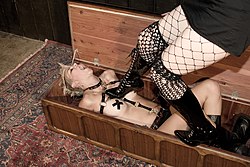Consent in BDSM

Consent within BDSM is when a participant gives their permission for certain acts or types of relationships. It bears much in common with the concept of informed consent and is simultaneously a personal, ethical and social issue. It is an issue that attracts much attention within BDSM, resulting in competing models of consent such as safe, sane and consensual and risk-aware consensual kink.[1] Observers from outside the BDSM community have also commented on the issue of consent in BDSM, sometimes referring to legal consent which is a separate and largely unrelated matter. However, the presence of explicit consent within BDSM can often have implications for BDSM and the law and, depending on the country the participants are in, may make the differences between being prosecuted or not.
Where an act has been previously consented to, the consent can be terminated at any point, and by any participant, through using a safeword.[2] Within the BDSM community, it is generally considered a high risk activity to engage in BDSM without a safeword. Acts undertaken with a lack of explicit consent may be considered abusive and those who ignore the use of a safeword may be shunned within the BDSM subculture.[3][4] One study has shown that BDSM negotiations to establish consent consist of four parts covering style of play, body parts, limits and safewords.[5]
Consensual non-consent
Consensual non-consent (CNC), also referred to as a "power exchange kink" within the BDSM community, is a type of erotic roleplay that plays out as though it is non-consensual but has in fact been consented to. Consensual non-consent includes any form of BDSM play where it has been agreed in advance that the standard means of revoking consent, for example saying "stop", "no", or "don't", will not apply. The majority of BDSM practitioners who participate in consensual non-consent activities will uses prearranged safewords as a means of revoking consent.[6][7][8][9][10]
Models and philosophy
BDSM communities share a common language of consent. Various models are expressed as acronyms representing differing approaches towards a philosophy of consent.
SSC
Safe, sane, and consensual (SSC) is the most recognizable and popular model of consent in BDSM circles, though not without criticism.[11] It means that everything is based on safe activities, that all participants are of sufficiently sound mind in their conduct, and that all participants do consent.
RACK
Risk-aware consensual kink (RACK) is the second most popular consent model. It is generally permissive of certain risky sexual behaviors, as long as the participants are fully aware of the risks. It was created to overcome perceived shortcomings of SSC.[12]
Other models
Other less well known models of consent in BDSM include CCC, which stands for Committed, Compassionate, Consensual and the 4 C's — Caring, Communication, Consent, Caution.[13]
Legal aspects
The 2007 conviction of Glenn Marcus on counts of sex trafficking and forced labor in renewed much debate on the issue of consent in BDSM, both within and outside the community.[14] In a similar case of an accusation made by a participant that the activities had not been consensual, in April 2007 two UK men were convicted of false imprisonment in a case where a third party who had been treated like a dog asserted the matter had not been consensual.[15]
See also
References
- ^ Williams, D.J. (2014). "From "SSC" and "RACK" to the "4Cs": Introducing a new framework for negotiating BDSM participation". Journal of Human Sexuality. 17: 1–10 – via Gale Academic.
- ^ Brown, Ashley (2019). "A Systematic Scoping Review of the Prevalence, Etiological, Psychological, and Interpersonal Factors Associated with BDSM". Journal of Sex Research. 57 (6): 781–811. doi:10.1080/00224499.2019.1665619. PMID 31617765 – via Taylor & Francis.
- ^ ”collarncuffs.com on safewords”
- ^ Holt, Karen (2016). "Blacklisted: Boundaries, Violations, and Retaliatory Behavior in the BDSM Community". Deviant Behavior. 37 (8): 917–930. doi:10.1080/01639625.2016.1156982 – via Taylor & Francis.
- ^ “Conversational-Phases-in-BDSM-Pre-Scene-Negotiation” Journal of Positive Sexuality
- ^ Twiss, Chelsea (November 30, 2023). "Consensual Non-Consent: Are CNC Kinks Normal?". Retrieved October 19, 2024.
- ^ "Safe Words: What You Need to Know".
- ^ "CNC Kink Play 101: Learn Everything About Consensual Non-Consent". 18 April 2022.
- ^ "51 Effective Safe Words to Use During Your Next BDSM Scene". 24 March 2023.
- ^ "Safewords, CNC, and How We Define Consent". 16 September 2017.
- ^ Jacques, Trevor (1993). On the Safe Edge: A manual for SM play (1st ed.). Toronto, Canada: WholeSM Publishing. pp. 3–4. ISBN 9781895857054.
- ^ Switch, Gary (2001). ""Origin of RACK: RACK vs. SSC"". Vancouver Leather. Archived from the original on 2009-05-01. Retrieved 2024-04-18.
- ^ Kaak, Ayesha. "B&D, S&M, D&S, RACK, PRICK, SSC... An entree of acronym soup and kink". Australian National University.
- ^ ""Sex Slave Trial" New York Post". Archived from the original on 2007-03-12. Retrieved 2007-03-19.
- ^ "Man was forced to live like a dog" - BBC News. (Analysis of consent issues on BDSM forum Archived 2007-09-29 at the Wayback Machine)
